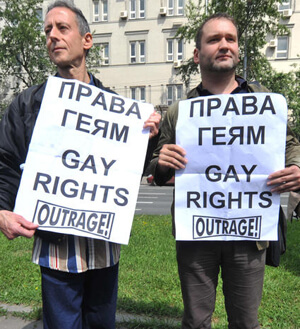It was a lazy weeknight in the men’s locker room at the Prospect Park Y. “Have a good workout,” a lanky man changing next to me said, as the squat, gym-attired guy he was talking to kissed him on the lips.
The kiss was an innocuous act of affection — more a peck than a tongue-in-mouth, go-get-a-room smooch. Yet witnessing this scene left me feeling that my heterosexual space had been violated.
As a 56-year-old straight male I have seen public displays of affection between men evolve from an oddity to a mainstream occurrence. In the 1970s and ‘80s, it was mostly confined to the West Village, where my Upper East Side friends and I would go to inhale progressive New York and — much to my later shame — find ourselves snickering at men kissing and holding hands. In more recent years kissing males could be glimpsed all over town: on sidewalks, restaurants, subways, and buses.
Through most of adulthood I was uncomfortable watching these gay lovers and participated in their repression, making crude jokes about their sexuality. Nowadays when I encounter same-sex couples sharing a physical connection I see it as an unremarkable part of the city’s scenery.
My shift in attitude began when I started a 15-year stretch at my job working for a lesbian, who was living with her long-time partner. They seemed happier and more committed to each other than most straight couples I knew, making it impossible for me to deny the legitimacy of their love.
More recently I fell in love with and became engaged to a woman who was active in a synagogue that had numerous families led by gays and lesbians. I joined the synagogue, and as I socialized with these gay couples and played with their children, I slowly came to perceive these families as no different than heterosexual-led households.
It was a relief — even freeing — to encounter gays and lesbians without focusing on their sexuality. Still, my ease with sexual orientation stopped at the locker room door, where I reverted to traditional notions of sexuality.
My stubbornness over this aspect of manhood stems from the awkwardness surrounding locker room nudity. I was always careful not to allow my eyes to even glimpse the genitalia displayed in the showers or sit too close to someone in the steam room, lest I be suspected of homosexuality.
In one gym I belonged to I would sometimes find myself naked in the steam room with a gay rights activist I knew from local politics. As we took our schvitz, I would become acutely aware of his sexual orientation, even though I never thought about it when we ran into each other, fully clothed, at political events.
I dealt with these sweat-inducing encounters and the knowledge that there were other gays in the locker room by convincing myself that such males turned off their sexuality when they entered a health club. Holding to the fiction that the locker room was an asexual zone protected me from the homoerotic undertones of interacting with all the unclothed bodies I encountered in the showers, steam room, and locker rows.
The kiss destroyed that fiction and made me annoyed with being forced to re-conceptualize the one corner of my world that had been untouched by the gay rights movement. But I quickly realized that I was being unfair –– the locker room belongs to everyone with a gym membership, after all.
My discomfort with the kiss derived from a latent unease with the idea of men loving men. The locker room was the last frontier of my homophobia.
As traditional bastions of machismo become integrated, men like me will have to become more inclusive or find ourselves out of step with society’s hurried pace toward equality. In the end, there will be a revised definition of masculinity that is both broader than the old one and truer to what manhood really is.




































